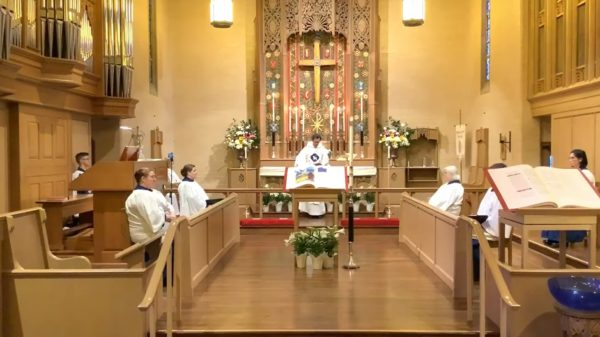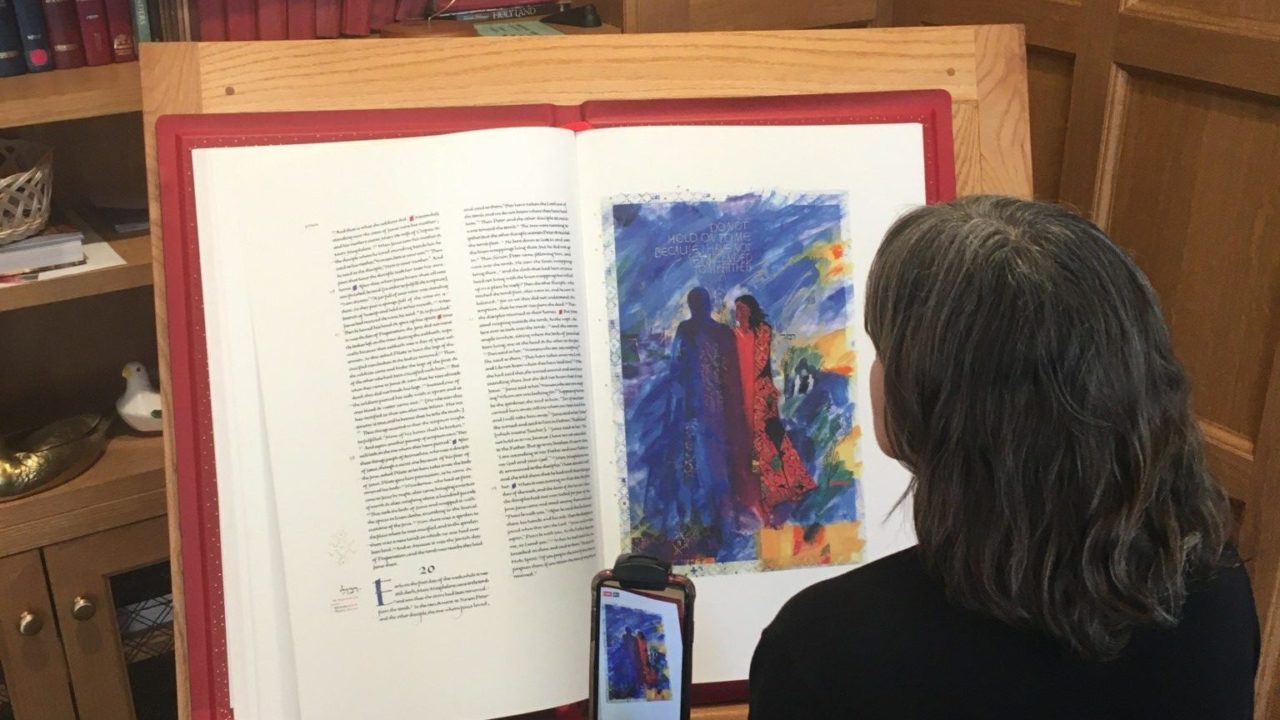As the Covid-19 pandemic disrupts planned gatherings around the world, countless church communities have been asking themselves how they can best come together and carry on traditions remotely. At Epiphany Parish in Seattle, The Saint John’s Bible has played a helpful role in these efforts, serving as a familiar touchstone in an unfamiliar environment.
Pivoting to a Virtual Read-Aloud
For the past six years, parishioners at Epiphany have observed Good Friday with a gospel read-aloud. Previously, these six-hour events have been conducted in the church’s Fireside Room, with parishioners invited to drop in to listen or to take a turn reading from the Heritage Edition.
Diana Bender, the Ministry Leader for Discernment at Epiphany, who started the Good Friday reading tradition, recounted how this year’s circumstances required a change of plans.
“When it became clear that we weren’t going to be able to do Easter in person as a congregation, I started thinking about the different events that happened during Holy Week and what I would do differently for the things that I was leading as a lay volunteer,” she said. “I did a virtual Day of Quiet for Lent, eight days before Palm Sunday. And then we started exploring the idea of a virtual Gospel read-aloud.”
While such an undertaking might have been too much for one person to handle alone, Diana was fortunate to have the assistance of another person in her household – her son Tieran, home from his junior year at Reed College.
Streaming a Tradition

Provided with a key to the church, Diana and Tieran set up The Saint John’s Bible in the Fireside Room on Good Friday, just as in past years. With a phone attached to a tripod next to the Bible, Diana and Tieran streamed their reading on Facebook Live using the church’s profile. The pair read aloud the entire Gospel of John and much of Luke over the duration of about four and a half hours. By taking turns reading and monitoring the feed, both Diana and Tieran were able to observe the engagement of virtual visitors.
“The average number of minutes that people watched was actually quite high,” Diana said. “There was a big group that was in the 45 minutes to one hour range. And people texted us during the reading, saying, ‘Thank you so much for doing this.’”
The event’s shift to Facebook had the additional effect of putting Epiphany’s tradition in front of new audiences. “I posted on my personal Facebook page, ‘I’m doing this reading; join us if you can,’” Diana said. “And some friends outside Epiphany messaged me later to say how much they appreciated it.”
New Meaning to the “Cloud of Witnesses”
The Rev. Doyt Conn, Rector at Epiphany, explained that while the church has streamed its services online for some time, the pandemic has “accelerated the future.” Conn estimated that attendance for online services on the church’s YouTube channel was previously around 60 people, but Epiphany’s numbers have recently jumped to around 450 virtual attendees.
“So many institutions have been doing virtual business for a long time,” he said, “but now everyone’s there instantly. So as I think about the church, we have to be there instantly as well. All of the sudden, the ‘cloud of witnesses’ is actually in the cloud.”
Conn noted that the Good Friday reading with the Heritage Edition was an event that was particularly well suited for a move online. “It’s perfect because it’s not only the auditory connection of hearing the Bible read by a friendly, familiar voice, but it’s also seeing the beauty of The Saint John’s Bible – its esthetic. It magnified people’s capacity to engage,” he said.
“We must change because the world’s changed.”

The Heritage Edition continues to play a role in many of the church’s online events. “It brings scripture to life in an even bigger way online when we incorporate that big book into our service,” Conn said. “We do it incarnationally in the regular services that we’ve done, but now it takes on a more profound and prominent role you’ll see visually in the service itself.”
Conn credits the staff and community at Epiphany for embracing the change that was called for and creating online programming for Maundy Thursday, Good Friday and the Holy Vigil “in a way that both honored the liturgical pattern and was engaging online.”
“The church has to shift to this new reality,” Conn said, “and that’s scary because we’re a vital Episcopal church in the regular old Episcopal church tradition. But we can’t rest in that in this new time. We must change because the world’s changed.”
For Diana and Tieran, the Gospel readings on Good Friday provided a sense of meaning amid the change. “The certainty of the ritual was meaningful for me,” said Tieran. “The pattern – where there’s regularity and certainty in what comes next – can be really helpful, especially right now when things are so uncertain.”
“Reading the Gospel as a whole, there’s a beginning, a middle and an end,” said Diana, “and the people in the middle didn’t know what the end was going to be. Seeing and hearing the end of the story – of the women going to the tomb and finding Jesus wasn’t there – was a really powerful reminder that we’re going to get the ‘resurrection’ at the end as well. We’re going to be together again. We’re going to discover some richness out of this experience – as a community at Epiphany and as a society. It might take a while for us to know what that is, but it’s coming. And that I found reassuring.”

